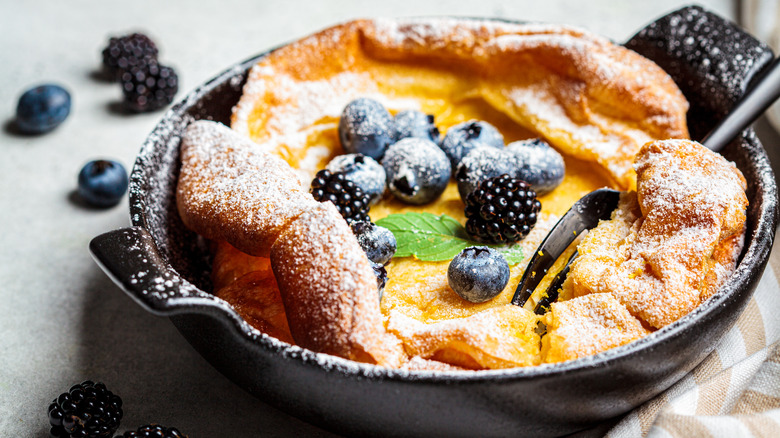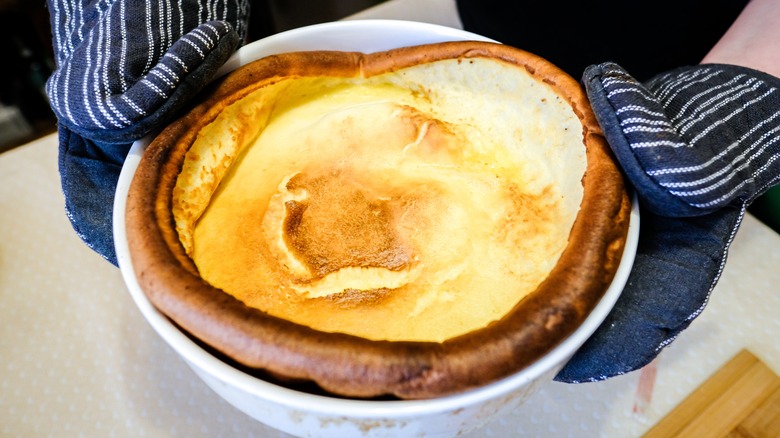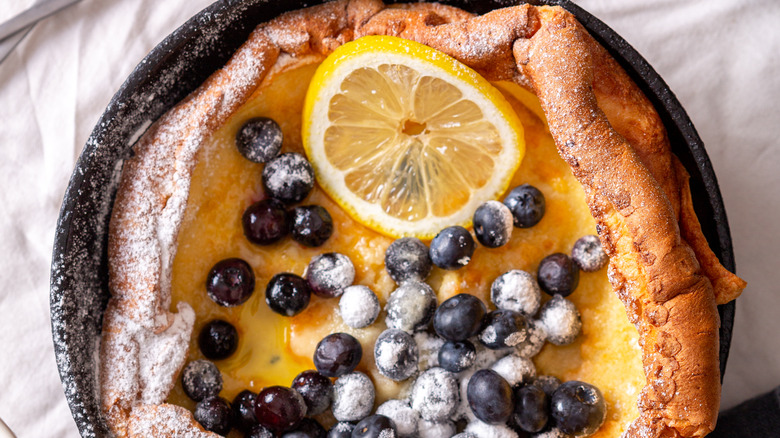Is A Dutch Baby Really Just A Large, Fluffy Pancake?
While bacon and eggs might be the star of your breakfast, there will almost certainly be some kind of bread beside them on the table. A few pieces of toast can be the perfect base for a balanced breakfast. In fact, it's been suggested that eating carbohydrates in the morning is an effective way to get your body started, as you will have the entire day to expend the excess energy and regulate the carbs' impact on your blood sugar level.
If a few pieces of dry white bread isn't exciting enough for you, there's a wide world of carbohydrates out there for you to enjoy. Waffles, French toast, and pancakes are arguably the most recognizable names in the game, but they are far from the be-all and end-all of breakfast dishes. By making your pancake thinner, and wrapping it around some filling, you've created a foreign and fancy-sounding crêpe. Another variation on the pancake is the Dutch baby, a treat whose staggering size makes a mockery of its infantile moniker.
What is a Dutch baby, and how do you enjoy it?
Though Dutch baby is probably the most recognizable name for this colossal breakfast crêpe, it is also known as a German pancake, an oven pancake, or a popover. A Dutch baby recipe will likely be familiar to anyone who has flipped flapjacks, combining flour, egg, milk, and fat. The Dutch baby differentiates itself from other breakfast bread during the cooking process. Instead of fluffing up and getting crispy as it's fried, a Dutch baby takes on its trademark texture in the oven.
Dutch babies provide diners with a perfect cross-section of tastes and textures. Traditionally, they are baked in a skillet. The batter that rests on the sides of the screaming hot skillet expands, resulting in a thin, crispy rim, while the center of the Dutch baby remains dense, soft, and custardy. While it cooks, a Dutch baby almost resembles a balloon, as moisture causes the rim to rise. When cooking perfectly, your Dutch baby should look like a bowl, with a substantial base and delicate sides.
The origins of the Dutch baby
Despite the fact that the dish is nomenclatural and associated with the Netherlands, ordering a Dutch pancake will not result in a hot skillet full of Dutch babies being pulled from the oven. Actual Dutch pancakes, or as they're called in the region, pannenkoeken, are essentially thin, wide, crêpe-like concoctions, which can be paired with either sweet or savory ingredients, depending on the diner's personal taste preferences.
Interestingly enough, Dutch babies are neither Dutch nor German. In fact, the first Dutch baby was baked in 1940s Seattle.
Regarding toppings, chefs generally go in a sweet direction with a Dutch baby. Fruit, be it a sprinkling of fresh berries or a filling of cinnamon apples, are a popular option. Alternatively, you can go down an even more straightforward route, and give your already sweet Dutch baby a subtle finish with a dusting of sugar or a touch of fresh lemon juice.


